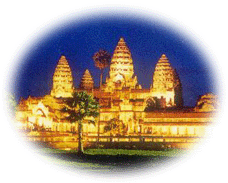| INTERESTING
|
|
Baksei Chamkrong Temple
|
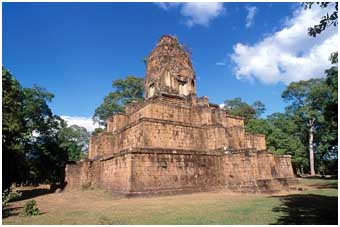 Located 150m north of Phnom Bakheng and 80m from the road leading to the South Gate of Angkor Thom, built in the middle of the tenth century by the King Harshavarman I (910-922). It was once decorated with a covering of mortar of lime. Like virtually all the structures of Angkor, it opens to the east. In the early 10th century, Harshavarman I erected five statues in this temple: two of Shiva, one of Vishnu and two of Devi.
Located 150m north of Phnom Bakheng and 80m from the road leading to the South Gate of Angkor Thom, built in the middle of the tenth century by the King Harshavarman I (910-922). It was once decorated with a covering of mortar of lime. Like virtually all the structures of Angkor, it opens to the east. In the early 10th century, Harshavarman I erected five statues in this temple: two of Shiva, one of Vishnu and two of Devi.
According to the legend, the king fled during an attack on ngkor and was saved from being caught by the enemy when a large bird swooped down and spread its wing to shelter the king. The name of the temple derives from this legend. The visit can be combined with a stop at the South Gate of Angkor Thom.
Angkor Thom Temple
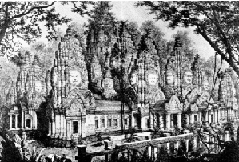 Located 1,700m north of Angkor Wat, enter and leave by the south, north or Victory gates. Angkor Thom was built by Angkor's greatest King Jayavarman VII (ruled 1181-1219) who came to power just after the disastrous sacking by the Chams of the previous Khmer capital. Angkor Thom is enclosed by a square wall 8m high and 12km in length and encircled by a moat 100m wide, said to have been inhabited by fierce crocodiles. The city has five monumental gates, one each in the north, west and south walls and two in the east wall. The gates, which are 20m in height, are decorated to either side of the passageway with stone elephant trunks and crowned by four gargantan faces of the Bodhisattva Avalokiteshvara facing the cardinal directions. In fron of each gate stand giant statues of 54 gods (to the left of the causeway) and 54 demons (to the right to the causeway). In the centre of the walled enclosure are they city's most important monuments, including the Yayon, the Baphuon, Vimean Akas, the Royal Enclosure, Terrace of Elephants, preah Philalay, Tep Pranam and Prasat Suor Prat.
Located 1,700m north of Angkor Wat, enter and leave by the south, north or Victory gates. Angkor Thom was built by Angkor's greatest King Jayavarman VII (ruled 1181-1219) who came to power just after the disastrous sacking by the Chams of the previous Khmer capital. Angkor Thom is enclosed by a square wall 8m high and 12km in length and encircled by a moat 100m wide, said to have been inhabited by fierce crocodiles. The city has five monumental gates, one each in the north, west and south walls and two in the east wall. The gates, which are 20m in height, are decorated to either side of the passageway with stone elephant trunks and crowned by four gargantan faces of the Bodhisattva Avalokiteshvara facing the cardinal directions. In fron of each gate stand giant statues of 54 gods (to the left of the causeway) and 54 demons (to the right to the causeway). In the centre of the walled enclosure are they city's most important monuments, including the Yayon, the Baphuon, Vimean Akas, the Royal Enclosure, Terrace of Elephants, preah Philalay, Tep Pranam and Prasat Suor Prat.
Bayon Temple
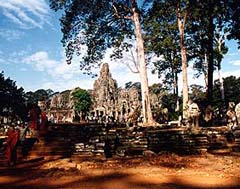 Located in the Centre of Angkor Thom, built in late 12th and early 13th century by the King jayavarman VII and dedicated to Buddhism. The Bayon takes an easy second place after Angkor Wat as the most popular of Angkor's complex. The Bayon remains one the most enigmatic temples of the Angkor group. Its symbolism, original form and subsequent changes and constructions have not yet been untangled. The architectual scale and composition of the Bayon exude grandness in every aspect.
Located in the Centre of Angkor Thom, built in late 12th and early 13th century by the King jayavarman VII and dedicated to Buddhism. The Bayon takes an easy second place after Angkor Wat as the most popular of Angkor's complex. The Bayon remains one the most enigmatic temples of the Angkor group. Its symbolism, original form and subsequent changes and constructions have not yet been untangled. The architectual scale and composition of the Bayon exude grandness in every aspect.
 Its elements juxtapose each other to create balance and hasmony. Bayon is the place of stooped corridors, precipitous flights of stairs and, most of all, a collection of 54 gothic towers decorated with over 200 smiling, gargantuan faces of Avalokiteshvara. The characteristics of these faces - a broad forehead, downcast eyes, wide nostrils, thick lips that curl upwards slightly at the ends- combine to reflect the famous "smile of Angkor". A number of Cambodian people point out that the Khmer empire was divided into 54 provinces at the time of the Bayon's construction, hence the all-seeing eyes of Avalokiteshvara were keeping watch on the kingdom's far-flug subjects. The surrounding tall jungle makes Bayon a bit dark and flat for photographs very early and late in the day.
Its elements juxtapose each other to create balance and hasmony. Bayon is the place of stooped corridors, precipitous flights of stairs and, most of all, a collection of 54 gothic towers decorated with over 200 smiling, gargantuan faces of Avalokiteshvara. The characteristics of these faces - a broad forehead, downcast eyes, wide nostrils, thick lips that curl upwards slightly at the ends- combine to reflect the famous "smile of Angkor". A number of Cambodian people point out that the Khmer empire was divided into 54 provinces at the time of the Bayon's construction, hence the all-seeing eyes of Avalokiteshvara were keeping watch on the kingdom's far-flug subjects. The surrounding tall jungle makes Bayon a bit dark and flat for photographs very early and late in the day.
Baphuon Temple
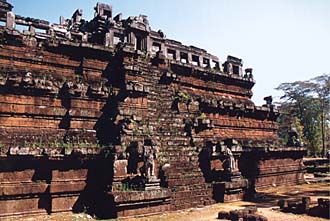 Located 200m Northwest of the Bayon and south Vimean Akas, built in 1060, by the King Udayadityavarman II (1050-1066), and dedicated to Shiva. The Baphuon, a pyramidal representation of mythical Mt. Meru. It is aproached by a 200m elevated walkway made of sandstone. The central structure is 43m high. An intersting feature of Baphuon are the basrelief's which are scences carved in small squares. The narrative themes are reaslistic depictions of daily life and forest scenes. The main temples are undergoing restoration and not open to the public.
Located 200m Northwest of the Bayon and south Vimean Akas, built in 1060, by the King Udayadityavarman II (1050-1066), and dedicated to Shiva. The Baphuon, a pyramidal representation of mythical Mt. Meru. It is aproached by a 200m elevated walkway made of sandstone. The central structure is 43m high. An intersting feature of Baphuon are the basrelief's which are scences carved in small squares. The narrative themes are reaslistic depictions of daily life and forest scenes. The main temples are undergoing restoration and not open to the public.
 Royal Enclosure & Vimean Akas Vimean Akas stands close to the centre of a walled area that once housed the roal palce, not that there's anything left of it today except two sandstone pools near the northern wall. Once the site of royal ablutions, these are now used as swimming holes by local childrn. It is fronted to the east by the Terrace of Elephants. The palace was used by Jayavarman V and Udayadityavarman I. Phimean Akas means 'Celestial Palace', and some scholars contend that it was once topped by a golden spire. Today it only hints at its former splendour and looks a little the worse for wear. The temple is another pyramidal representation o mrt. Meru with three leves. Most of the decorative features of the temple are broken or have disapeared. Still, it is worth trudging up to the second and third levels (the stairs to the third level are steep) for good views of the Baphuon.
Royal Enclosure & Vimean Akas Vimean Akas stands close to the centre of a walled area that once housed the roal palce, not that there's anything left of it today except two sandstone pools near the northern wall. Once the site of royal ablutions, these are now used as swimming holes by local childrn. It is fronted to the east by the Terrace of Elephants. The palace was used by Jayavarman V and Udayadityavarman I. Phimean Akas means 'Celestial Palace', and some scholars contend that it was once topped by a golden spire. Today it only hints at its former splendour and looks a little the worse for wear. The temple is another pyramidal representation o mrt. Meru with three leves. Most of the decorative features of the temple are broken or have disapeared. Still, it is worth trudging up to the second and third levels (the stairs to the third level are steep) for good views of the Baphuon.
Taprohm Temple
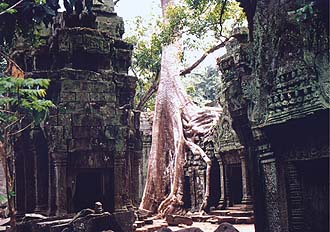 Another major site is Ta Prohm swallowed by the jungle, deliberately left much as it was found by French explorer; Henri Mouhot, who "rediscovered" the temples in the 1860s. A striking example of nature's triumph over man, the tentacle-like roots of vast trees slowly strangling and tearing apart this once- splendid human creation.
Another major site is Ta Prohm swallowed by the jungle, deliberately left much as it was found by French explorer; Henri Mouhot, who "rediscovered" the temples in the 1860s. A striking example of nature's triumph over man, the tentacle-like roots of vast trees slowly strangling and tearing apart this once- splendid human creation.
Located Southwest of the East Mebon and east of Angkor Thom.
 Its outer enclosure is ner bt corner of Banteay Kdei. The temple of Ta Prohm rates with Angkor Wat and the Bayon as one of the most popular and is among the largest of the mounuments in the Angkor complex. its appeal lies in the fact that unlike the othre mounuments of Angkor, it has been left to be swallowed by the jungle, and looks very much the way most of the monuments of Angkor appeared when European explorers first stumbled upon them.
Its outer enclosure is ner bt corner of Banteay Kdei. The temple of Ta Prohm rates with Angkor Wat and the Bayon as one of the most popular and is among the largest of the mounuments in the Angkor complex. its appeal lies in the fact that unlike the othre mounuments of Angkor, it has been left to be swallowed by the jungle, and looks very much the way most of the monuments of Angkor appeared when European explorers first stumbled upon them.
Pre Rup Temple
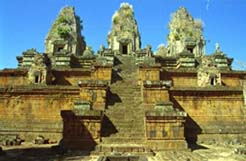 Located Northeast of Srah Srang and 500m south of the south and of the East Baray. Pre Rup was built by Raendravarman II (944-968) in 961 dedicated to Shiva. The name Pre Rup recalls on of the rituals of cremation in which the silhouette of the body of the deceased, outlined with its ashes is successively represented according to different orientations. Constructed on an artificial mountain in literate with brick towers, the plan is square and comprises two enclosures with four entry towers each and a base with three narrow tiers serving as a pedestal for five towers on the top platform-one in each corner and one central. The outerr enclosing wall is 127 by 116m.
Located Northeast of Srah Srang and 500m south of the south and of the East Baray. Pre Rup was built by Raendravarman II (944-968) in 961 dedicated to Shiva. The name Pre Rup recalls on of the rituals of cremation in which the silhouette of the body of the deceased, outlined with its ashes is successively represented according to different orientations. Constructed on an artificial mountain in literate with brick towers, the plan is square and comprises two enclosures with four entry towers each and a base with three narrow tiers serving as a pedestal for five towers on the top platform-one in each corner and one central. The outerr enclosing wall is 127 by 116m.
Banteay Srei Temple
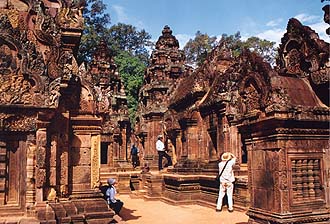 Banteay Srei was built not by a king, but by two local dignitaries, Yajnavaraha, who was a trusted guru to the king, and his brother. It was Rajendravarman I who granted them the land and permission for a temple to be built, but although the sanctuary was consecrated in 967 to Shiva, it was not actually completed until the reign of Jayavarman. The temple layout is relatively simple, with three enclosing walls, an inner moat and a row of three sanctuary towers at the very centre. If the eastern gopura by which you enter the temple seems olldly stranded, that's because threre was never an enclosing wall here-although the buildings just beyond the gopura are deemed to be in the "fourth" enclosure. The volume of tourists trooping past isn't conducive to lingering here, but it's worth taking a moment to scrutinise the very , which depicts Indra -- the sky god, ruling the esteerly cardinal direction -- squatting on the three - headed elephant Airavata.
Banteay Srei was built not by a king, but by two local dignitaries, Yajnavaraha, who was a trusted guru to the king, and his brother. It was Rajendravarman I who granted them the land and permission for a temple to be built, but although the sanctuary was consecrated in 967 to Shiva, it was not actually completed until the reign of Jayavarman. The temple layout is relatively simple, with three enclosing walls, an inner moat and a row of three sanctuary towers at the very centre. If the eastern gopura by which you enter the temple seems olldly stranded, that's because threre was never an enclosing wall here-although the buildings just beyond the gopura are deemed to be in the "fourth" enclosure. The volume of tourists trooping past isn't conducive to lingering here, but it's worth taking a moment to scrutinise the very , which depicts Indra -- the sky god, ruling the esteerly cardinal direction -- squatting on the three - headed elephant Airavata.
Siem Reap Map
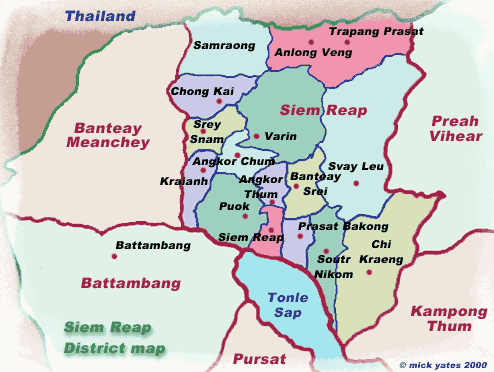
| Top | Angkor Thom | Bayon | Bapluon |Ta Prohm | Pre Rup | Banteay Srei | Siem Reap Map |
|
|
